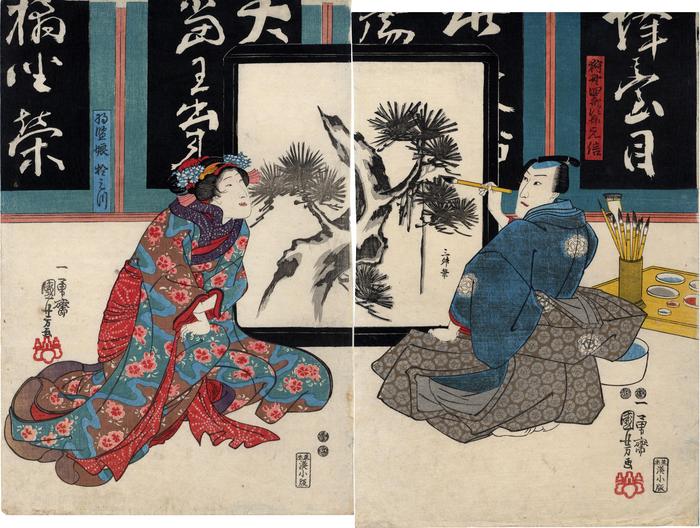Utagawa Kuniyoshi (歌川国芳) (artist 11/15/1797 – 03/05/1861)
Ichikawa Danjūrō VIII on the right as Kanō Motonobu (狩野四郎次郎元信) and Bandō Shūka I as the Shōgun's daughter Omatsu (将監娘おみつ)
03/05/1848
10 in x 14.5 in (Overall dimensions) Japanese color woodblock print
Signed: Ichiyūsai Kuniyoshi ga
一勇斎国芳画
Artist's seal: kiri
Publisher: Minatoya Kohei
(Marks 332 - seal 24-075)
Censors: Yoshimura and Maramatsu
Waseda University - left sheet
Waseda University - right sheet
Metropolitan Museum of Art - a six-panel screen by Kanō Motonobu
Kuniyoshi Project - a group of prints related to the play Mukashi-gatari inazuma zoshi
Virginia Museum of Fine Art The Kuniyoshi Project identifies this diptych as inspired by the play Mukashi-gatari inazuma zoshi (昔語稲妻帖). It was performed at the Ichimura-za in 1848.
****
The historical Kanō Motonobu lived from 1477-1559, according to the Metropolitan Museum of Art. Other sources give different dates.
Also called Ko-Hōgen, Eisen, Gyokusen, attended the lessons of his father Masanobu and those of Oguri Sōtan. He adopted a special style, borrowing from the Chinese and the Tosa school. He was in great favor with the Shōgun Yoshihisa, Yoshizumi, Yoshitane and Yoshiharu. He received the title of Echigo no kami and that of Hōgen after having his head shaved. He was a friend of the sculptor Gotō Yujō whom he supplied with most of his subjects. Motonobu is the most celebrated painter of the Kanō school.Quoted from: Historical and Geographical Dictionary of Japan by E. Papinot, who gives Motonobu's dates as 1476-1554.
****
The Encyclopedia Britannica on line says of this artist:
"Like his father, Masanobu, the first of the Kanō painters, Motonobu served the Ashikaga shoguns (a family of military rulers who governed Japan from 1338 to 1573) and inherited the Chinese-inspired monochromatic ink-painting style (suiboku-ga, “water-ink painting”) favoured by the Ashikagas. Motonobu, however, was also the son-in-law of Tosa Mitsunobu, founder of the Tosa school of painting specializing in the native Yamato-e (Japanese Painting) style, and he effected a compromise by combining the strong brushwork of the Chinese suiboku-ga with the decorative appeal of the Yamato-e. The resulting style was especially suitable for large-scale compositions and practically dominated Japanese painting for the next 300 years.
A gifted and versatile artist, Motonobu excelled in landscapes (both in monochrome and in light colour), figures, and flower-and-bird pictures. He executed many paintings on the sliding panels of the Reiun-in monastery in Kyōto, where he decorated three rooms with landscapes painted in the styles of three different Chinese masters: the soft ink-wash style of Mu-ch’i Fa-ch’ang (late 12th–early 13th century); the hard, stiff style of Hsia Kuei (1195–1224); and the broken ink style of Yü Chien (c. 1230). Some of Motonobu’s paintings, originally done on sliding panels, were subsequently mounted on hanging scrolls; these include the important “49 Landscapes with Flowers and Birds” (also in the Reiun-in monastery), which prefigure the monumental decorative compositions of the later Kanō artists, Eitoku (1543–1590) and Sanraku (1559–1635)."
****
Ex B. W. Robinson collection. 1848/3 An artist taking inspiration from a bijin in his screen painting of a pine tree.
****
This scene commemorates a performance of Mukashi gatari inazuma hyoshi (昔語稲妻帖).
Ichikawa Danjūrō VIII (八代目市川団十郎: 3/1832 - 6/8/1854) (actor)
Bandō Shūka I (初代坂東しうか: from 11/1839 to 11/1854) (actor)
actor prints (yakusha-e - 役者絵) (genre)
Minatoya Kohei (湊屋小兵衛) (publisher)
